Introduction and definitions
This page describes vesiculobullous and pustular injuries in newborns and their differentiating characteristics.
- A newborn is a newborn baby less than 28 days old.
- Vesicles They are small blisters that contain clear fluid.
- Bullas They are large blisters containing clear fluid.
- Pustules They are circumscribed lesions containing dense cellular contents.
Vesiculobullous and pustular lesions in neonates may be due to several benign conditions, a infection, a genodermatosis or a transient autoimmune bullous disorder.
Fluid-filled skin lesions.
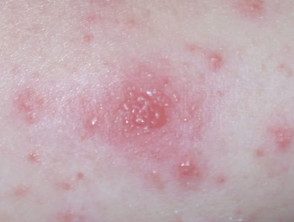
Vesicles due to eczema
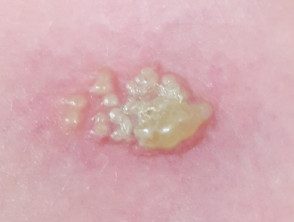
herpes simplex pustule
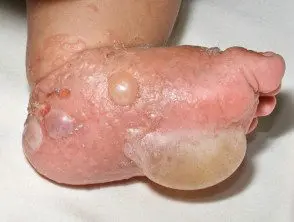
Bulla in bullous pemphigoid
Benign disorders that cause blisters and pustules in newborns.
There are several benign disorders that can present within days of birth with blisters and pustules. These include:
- Congenital sucking blisters - these are blisters and erosions on the forearm, hands, and fingers caused by the vigorous sucking of the fetus while in the womb
- Erythema toxicum neonatorum: this is a transient combination of erythematous macules, papulesand pustules on the face, trunk, and extremities
-
Transient neonatal pustular melanosis: this rare pustular condition may be a variant of neonatal erythema toxicum
-
Neonatal acne: this presents with comedones on the scalp, upper chest, and back and inflammatory lesions on the cheeks, chin and forehead.
Benign neonatal conditions
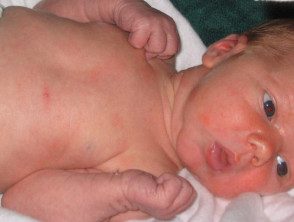
Toxic erythema neonatorum
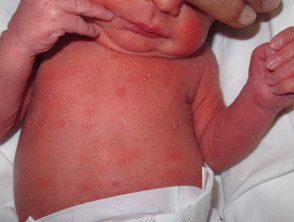
Neonatal pustular melanosis
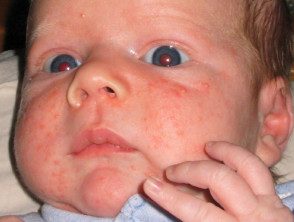
neonatal acne
Neonatal blisters can be due to viruses, bacterial, fungal or parasitic infection.
Viral infection
-
Herpes simplex virus (HSV) is the most common viral infection in newborns.
- Varicella zoster virus (VZV) is the cause of chickenpox and shingles.
- Coxsackiev viruses and other enteroviruses cause hand, foot, and mouth disease.
- Cytomegalovirus (CMV) is a rare cause of blisters.
The onset of viral infections occurs within days to weeks after birth.
- HSV and VZV present as grouped vesicles on an erythematous base, evolving to pustules and then crusted erosions.
- Located Blisters due to herpes simplex are often found on the face and scalp, and sometimes on the trunk and buttocks. newborns can develop disseminated HSV.
- HSV may be associated with prematurity and low birth weight and may complicate other vesiculopustular disorders.
- Primary Varicella infection in neonates (varicella) has a high mortality rate of 25%.
Viral infections that cause blisters.

Hand, foot and mouth
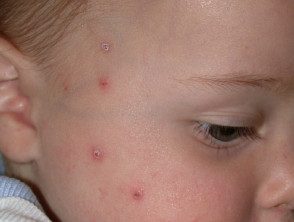
Chickenpox
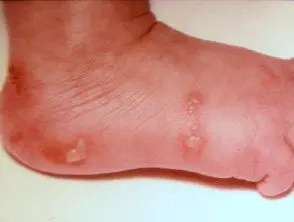
Herpes Simplex
bacterial infection
- Staphylococcus aureus can cause impetigo or staphylococcal scalded skin syndrome (SSSS)
- Streptococcus pyogenes may cause impetigo, erysipelas, or cellulitis.
- Pseudomonas aeruginosa can cause abscesses nodulesor cellulite
- Listeria monocytogenes It is the cause of listeriosis.
- Treponema pallidum causes congenital syphilis.
Staphylococcal infection in a newborn usually presents with a superficial location, flaccidVesiculobullous or pustular lesions that rupture to reveal an erythematous base and then form seropurulent crusts. The infection can spread to cause fever and extended SSSS [1].
Listeriosis is a cause of preterm labor. Presents early with multiple pustules on the mucous membranes and skin and can progress to cause meningitis and septicemia [1].
Congenital syphilis is associated with generalized hemorrhagic blisters and petechiae.
Staphylococcal infections in newborns
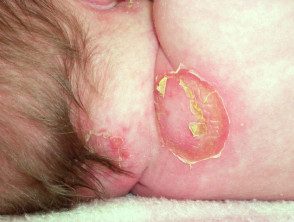
Blistering impetigo
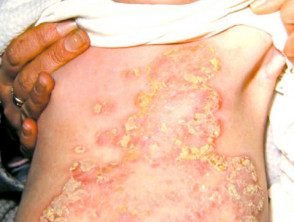
generalized impetigo
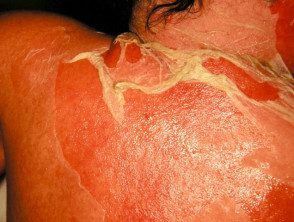
Staphylococcal scalded skin syndrome
mycoses
An infection caused by Candida albicans tends to occur a few weeks after birth or in an older baby, often presenting as oral thrush (gummy white plates in a flushed mucous membrane) or napkin dermatitis. Candida infections are characterized by very superficial blisters and pustules associated with erythematous papules and plaques on intertriginous sites. Systemic Mycosis with disseminated candida can also occur in neonates [1].
Candida albicans oral infection
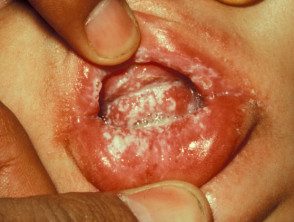
Oral thrush in a baby
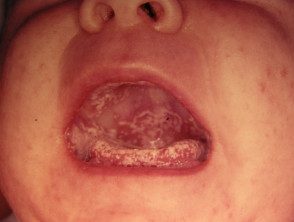
Oral thrush in a baby
Parasitic infection
Scabies is caused by the parasite. Pinch Sarcoptes scabiei. In a young baby, it causes generalized vesiculopustular. eruption, which is prominent on the palms and soles. the source of the infestation it is likely to be an itchy family member or visitor eruption [1].
Scabies in a baby
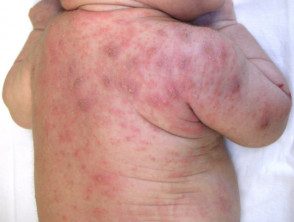
rash in a baby

Scabies on the sole of a baby
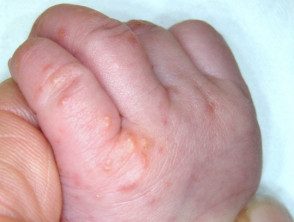
Scabies on a baby's hand
ampoules of genodermatosis in neonates
Blistering genodermatosis are:
- Epidermolysis bullosa
- Epidermolytic ichthyosis
- Aplasia skin congenital
- Incontinentia pigmenti
- Cutaneous mastocytosis
-
Congenital forms of porphyria.
Vesiculopustular genodermatosis and hereditary blisters are rare. They should be suspected in newborns with a family history of genodermatosis or consanguinity [2].
- The clinical diagnosis of epidermolysis bullosa may not be reliable due to the variable presentation. Epidermolysis bullosa is associated with generalized skin. fragility and blisters on minors trauma and has extracutaneous demonstrations [2].
- Epidermolytic ichthyosis is a keratinopathy that presents with generalized blisters and climbing. A localized variant causes a epidermal nevus [1].
-
Aplasia cutis congenita is congenital. focal no skin, most often an isolate injury middle line of the later scalp. It is sometimes associated with other physical defects or disorders. [1].
-
Incontinentia pigmenti occurs along Blaschko lines (for example, as a linear rash on a limb). It has four stages of development vesicular, warty, hyperpigmentedand atrophic/ /hypopigmented stages) that may be present simultaneously; Blistering is a feature in 50% cases. [1].
Genodermatosis that can form blisters.
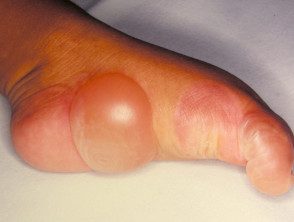
Epidermolysis bullosa
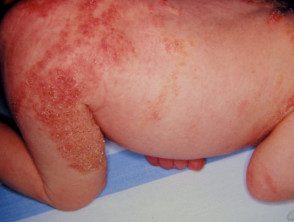
Incontinentia pigmenti

Cutaneous mastocytosis
Blisters due to transient autoimmune diseases in neonates
A maternal history of an autoimmune blistering disease may lead to a newborn presenting with the same autoimmune blistering disorder. Maternally transmitted autoimmune blistering disorders usually resolve within a few months after birth. [1]. These include:
- Pemphigus vulgaris
- Leaf Pemphigus
- Bullous pemphigoid
- Acquired epidermolysis bullosa
-
Linear immunoglobulin A skin disease.
What tests should be done on a newborn with blisters?
An initial investigation in a newborn with blisters includes scraping fluid and cells from an intact blister for viruses/bacteria/fungi. microscopy, cultureand tests for Polymerase chain reaction to specific organisms [1,2].
A skin biopsy, with or without direct immunofluorescence, should be performed if the infectious test is negative and in those patients refractory to initial therapy [3].
Cultures of blood, urine, and cerebrospinal fluid can be used to detect disseminated disease in SSSS and herpes simplex [1].
Genodermatoses can be confirmed by skin biopsy using standard light microscopy, transmission electron microscopeand immunofluorescence microscopy. Molecular genetic evidence should also be considered [2].
An autoimmune blistering disease is investigated by a cable blood sample with serum indirect immunofluorescence on salt-split skin, and autoantibody enzymeimmunosorbent assay linked to desmoglein 1 and 3 and bullous pemphigoid antigen BP180. If there is no history of blistering in the mother, a skin biopsy of the lesion should be performed to histopathology. A perilesional skin biopsy should be sent for direct immunofluorescence [2,4].
What is the treatment for blistering in newborns?
Treatment of bullous disease depends on the diagnosis.
A benign disorder such as neonatal acne, neonatal toxic erythema, and transient neonatal pustular melanosis is self-limiting and no specific treatment is required. [1].
Bacterial infection should be managed with empiric antibiotics according to the guidelines of each country.
Treatment of epidermolysis bullosa focuses on prevention, wound care, and optimization of nutrition. [two]. Aplasia cutis congenita is usually managed by conservative wound care.
Most cases of neonatal autoimmune blisters are self-limiting, and symptoms can be reduced by the use of current corticosteroids [3].
